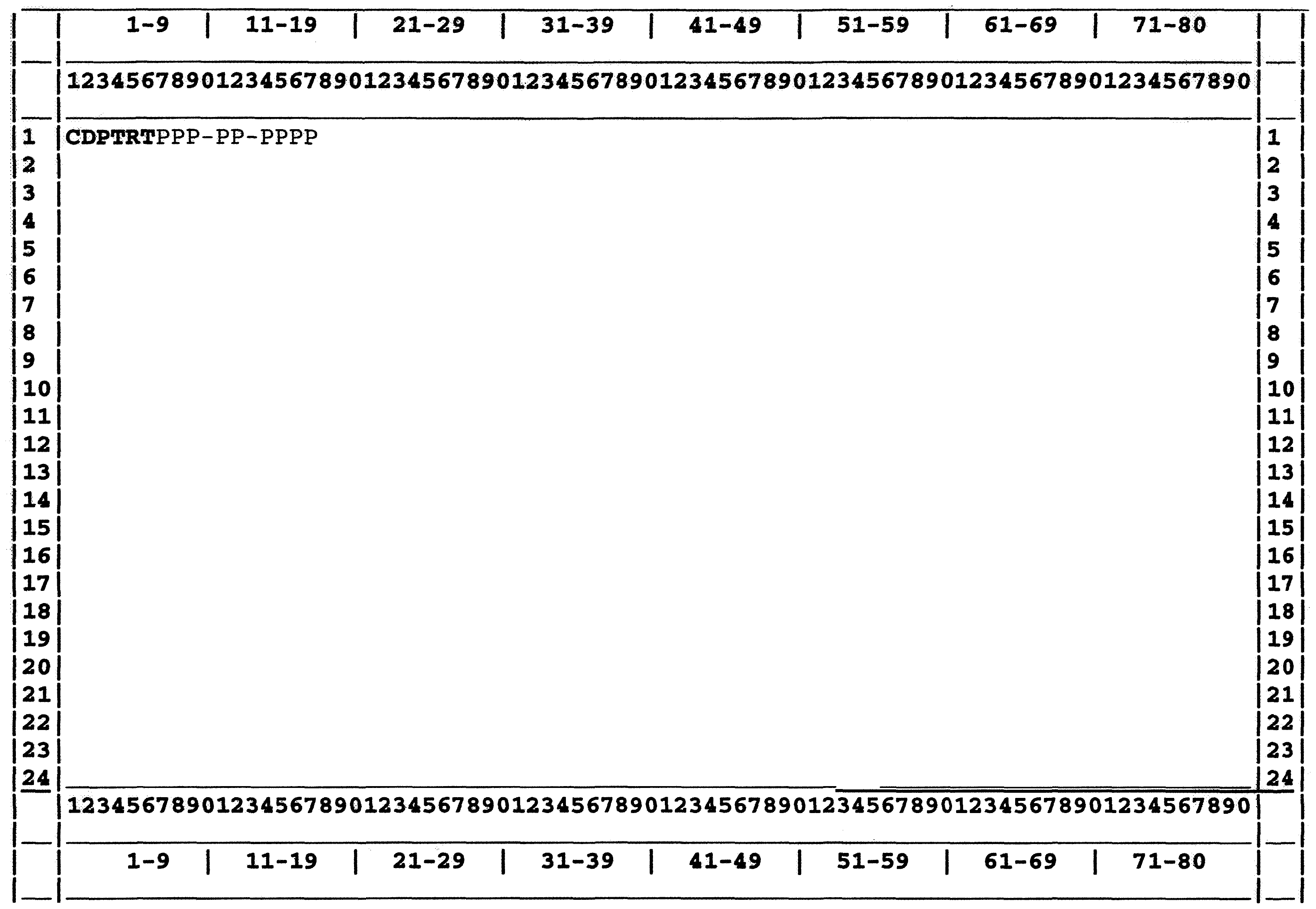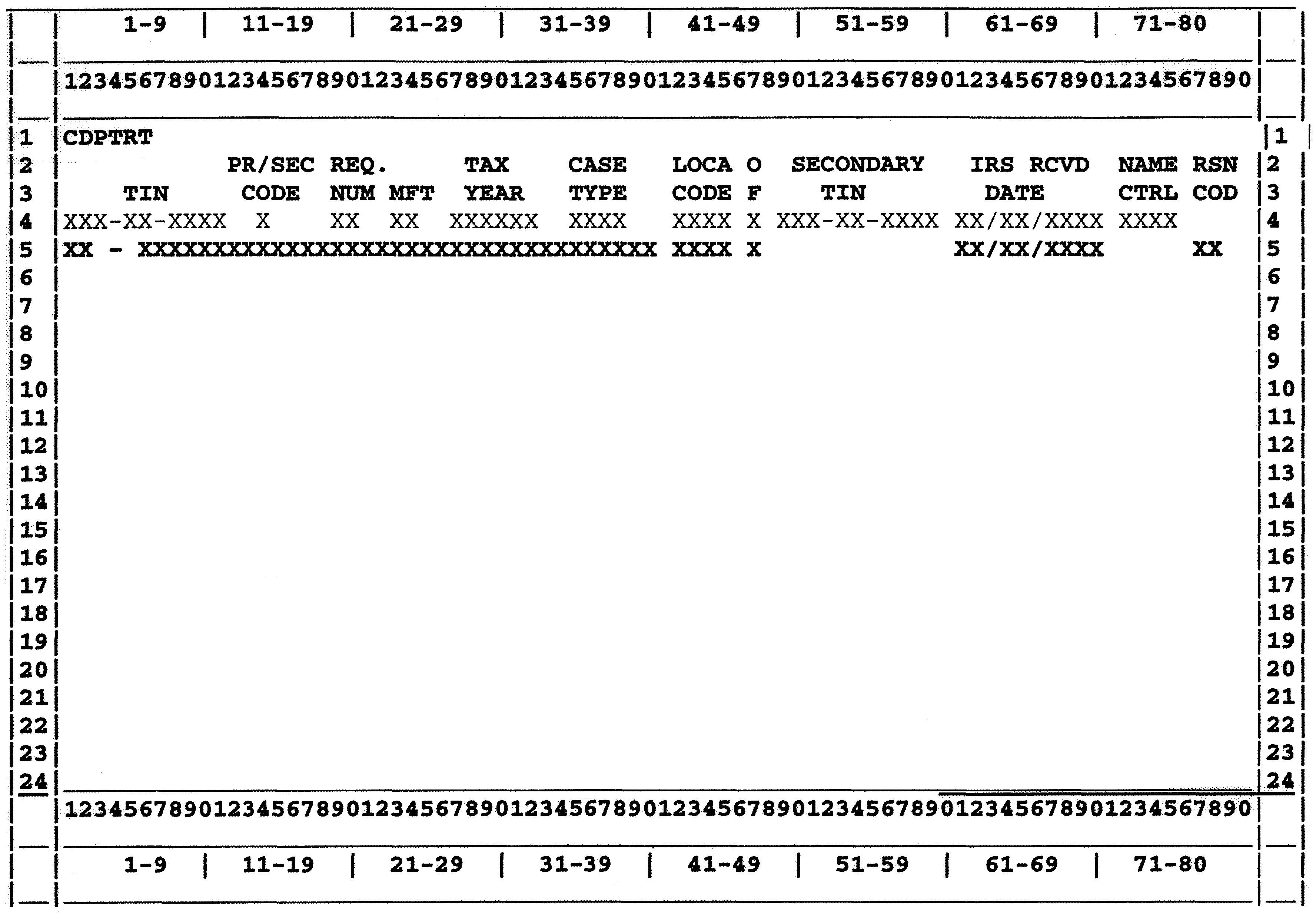- 2.4.57 Command Code CDPTR
- 2.4.57.1 Program Scope and Objectives
- 2.4.57.1.1 Background
- 2.4.57.1.2 Authority
- 2.4.57.1.3 Responsibilities
- 2.4.57.1.4 Program Management and Review
- 2.4.57.1.5 Program Controls
- 2.4.57.1.6 Terms and Acronyms
- 2.4.57.1.7 Related Resources
- 2.4.57.2 General
- 2.4.57.3 Using CDPTR Definer T
- Exhibit 2.4.57-1 CDPTRT Input Screen
- Exhibit 2.4.57-2 CDPTRT Output Screen
- Exhibit 2.4.57-3 CDP LOCATION CODE TABLE
- Exhibit 2.4.57-4 CDP REASON CODE TABLE
- 2.4.57.1 Program Scope and Objectives
Part 2. Information Technology
Chapter 4. IDRS Terminal Input
Section 57. Command Code CDPTR
2.4.57 Command Code CDPTR
Manual Transmittal
November 20, 2023
Purpose
(1) This transmits revised IRM 2.4.57, IDRS Terminal Input, Command Code CDPTR.
Material Changes
(1) IRM 2.4.57.1 has been revised to include Internal Controls.
Effect on Other Documents
IRM 2.4.57, dated April 22, 2020, is superseded.Audience
LMSB, SB/SE, TE/GE, W&I.Effective Date
(01-01-2024)
Kaschit Pandya,
Acting, Chief Information Officer
-
This IRM section provides an overview of the CDPTR Command Code.
-
Purpose: These section provides instructions for inputting and researching the Collection Due Processing Tracking System.
-
Audience:These instructions are intended for campus tax examiners in Automated Collection System Support (ACSS).
-
Policy Owner: The Chief Information Officer (CIO) is responsible for overseeing all aspects of our systems that operate the nation’s tax infrastructure.
-
Program Owner: IT CIO
-
Primary: Campus operations ACS Support
-
Program Goals: Procedures for using the CDP tracking system is in 5.19.8, Liability Collection – Collection Appeal Rights.
-
This IRM and the contained sections provide the user the necessary information on how to use the command codes CDPTR via the CDP Web site.
-
The Collection Due Process Tracking System (CDPTS) is used by the campus CDP Units to keep track of the disposition of CDP/EH requests received.
-
CDP Project Lead is responsible for
-
Review and implementation of Work Requests that affect CDP command codes or CDP Web site
-
Updating the contents of this IRM
-
-
Program Reports:
-
Data source: MCC and TCC TIF
-
Data destination: MCC and TCC TIF
-
Primary purpose of this data: allows business units to work cases on IDRS.
-
Data description: Entity Record: Each individual taxpayer or business is assigned a unique identity that contains information about them such as SSN/EIN, name, and address. Module Record: These records are tax forms submitted by the taxpayer or business for a specific tax period and correspond to the entity record. Information that creates a unique key on this record would be the SSN/EIN, MFT (tax form), plan number, tax period, and control name. One or more module records can be assigned to an entity record. Transaction Record: Track the payment and refund activity for a specific module record. Transaction records must contain at least one transaction code. One or more transaction records can be assigned to a module record.
-
-
CDP Collection Due Process CDPTS CDP Tracking System EH Equivalent Hearing
-
The Collection Due Process Tracking System (CDPTS) is a cross-functional inventory system to track CDP Inventory from time of receipt through resolution. It allows Compliance areas to research CDP cases utilizing an IDRS Command Code (CDPTR) or input and update CDP cases via the web based Intranet system.
-
A Collection Due Process Record is added to a module on IDRS when a Form 12153 or other adequate CDP request is determined to be valid.
-
CDP Cases may be researched using Command Code CDPTR(Definer T), which will display the most recent actions on active cases selected by primary TIN.
-
CDPTR Definer T is designed to be used by Customer Service Representatives speaking with Taxpayers about their COLLECTION DUE PROCESS requests. It provides them with a summary of the current status for the request(s) of the Primary Taxpayer.
-
CDPTR Definer T is activated by inputting the formatted TIN of the Primary Taxpayer. See Exhibit 2.4.57–1.
-
CDPTR with Definer T produces a formatted summary of the current status of the case. Included in the summary is the Tin, Filer-Code, Tax Period, Request Number, IRS Rcvd Date, Name Ctrl, MFT, Case Type, Location Code, Office Function, Secondary TIN and Reason Code in the information about the current stage of the case. See Exhibit 2.4.57–2.
INPUT SCREEN DISPLAY FOR CC CDPTR:

Please click here for the text description of the image.
The above graphic is the input screen for CC CDPTR, used for CDP TELEPHONE RESEARCH of the primary taxpayer with the fields defined in the table below.
Record Element Description:
| Row | Position | Content |
|---|---|---|
| 1 | 1–5 | Command Code CDPTR |
| 1 | 6 | T (Definer) |
| 1 | 7–17 | Primary Taxpayer's SSN |
Output Screen Display for CC CDPTR:

Please click here for the text description of the image.
The above graphic is the Output screen for CC CDPTR used for CDP TELEPHONE RESEARCH which will display the current status of the primary taxpayer's case with the fields defined in the table below.
Record Element Description for CC CDPTR:
| Row | Position | Content |
| 1 | 1–6 | Command Code CDPTRT |
| 4 | 1–11 | Primary Taxpayer's SSN Requested |
| 4 | 14 | Case Filer Code Requested |
| 4 | 19–20 | Case Request Number |
| 4 | 23–24 | Mft |
| 4 | 27–32 | Tax Period Requested |
| 4 | 35–38 | Case Type |
| 4 | 42–45 | Location Code Original |
| 4 | 47–47 | Office Function Original |
| 4 | 49–60 | Secondary Tin (if applicable) |
| 4 | 61–71 | Date Stage 01 Received |
| 4 | 72–75 | Account Name Control |
| 6 | 1–2 | Stage Number |
| 6 | 7–40 | Output Message of current status of case(See table below) |
| 6 | 42–45 | Location Code Current |
| 6 | 47–47 | Office Function Current |
| 6 | 49-59 | Stage Message |
| 6 | 61-70 | Stage Date |
| 6 | 77–78 | Reason Code (See Exhibit 2.4.57–4) |
Output Messages for CC CDPTR Case Status:
| OUTPUT MESSAGES FOR STATUS OF CDP CASE | |
| STAGE | MESSAGES |
| [slashb] | NO REQUEST RECEIVED (THERE IS NO STAGE 01) |
| 01 — | 01 — RECEIPT OF HEARING REQUESTED 9999 X mm/dd/yyyy |
| 02 — | 02 — ACS FRONT END PROCESSING |
| 03 — | 03 — TRANSFERRED TO 9999 X mm/dd/yyyy |
| 04 — | RECEIVED BY 9999 X mm/dd/yyyy |
| 05 — | 05 —APPEALS REQUESTING INFORMATION FROM: 9999 SENT mm/dd/yyyy ZZ |
| 06 — | 06 — RETURN OF ARI TO APPEALS 9999 X RTRN mm/dd/yyyy |
| 07 — | 07– APPEALS DECISION AT LOCATION 9999 X mm/dd/yyyy ZZ |
| 08 — | 08– TAX COURT PETITION DATE 9999 X mm/dd/yyyy |
| 09 — | 09– TAX COURT DECISION DATE 9999 X mm/dd/yyyy |
| 10 — | 10– DISTRICT COURT PETITION DATE 9999 X mm/dd/yyyy |
| 11 — | 11– DISTRICT COURT DECISION DATE 9999 X mm/dd/yyyy |
| 12 — | 12– RESOLVED PRIOR TO HEARING 9999 X mm/dd/yyyy ZZ |
| 13 — | 13– HEARING CONCLUDED IN APPEALS 9999 X FINAL mm/dd/yyyy ZZ |
| 14 — | 14– CLOSED CASE RECVD FROM APPEALS 9999 X mm/dd/yyyy |
| 15 | 15–RETAINED JURISDICTION 9999 X mm/dd/yyyy |
| 16 | 16– APPEALS RETURNS RETAINED JURIS RTRN 9999 X mm/dd/yyyy ZZ |
| 24 | 24– CONCLUDING ACTIONS TAKEN 9999 X mm/dd/yyyy ZZ |
| Each case selected will be identified by the headings and associated data. The current status of the case is determined by the last stage, or stages present for that case. . Two or three of these case presentations can appear on one screen page. Note:"9999" refers to Location Code ( See Exhibit 2.4.57–3)."xx/xx/xxxx " refers to Stage Date and "XX" refers to Reason Code(See Exhibit 2.4.57–4). |
|
Please view IRM 2.3.79, Command Code CDPWEB (CDPTA, CDPTE) for the list of current Location Codes and their definitions.

 )
o https:// significa que usted se conectó de forma segura a un sitio web .gov. Comparta información sensible sólo en sitios web oficiales y seguros.
)
o https:// significa que usted se conectó de forma segura a un sitio web .gov. Comparta información sensible sólo en sitios web oficiales y seguros.
